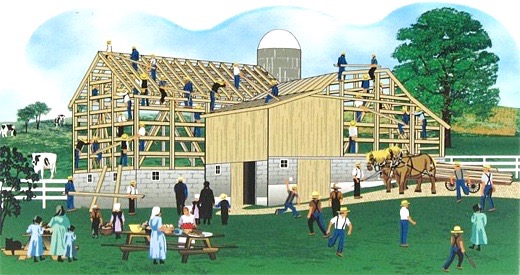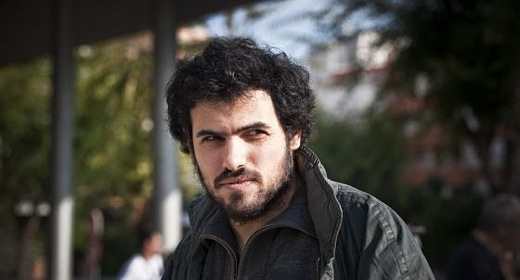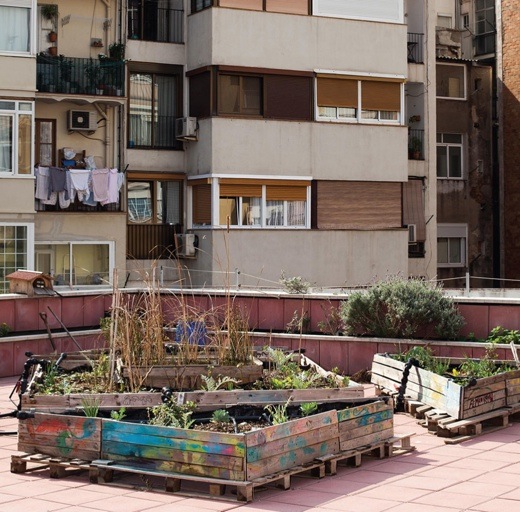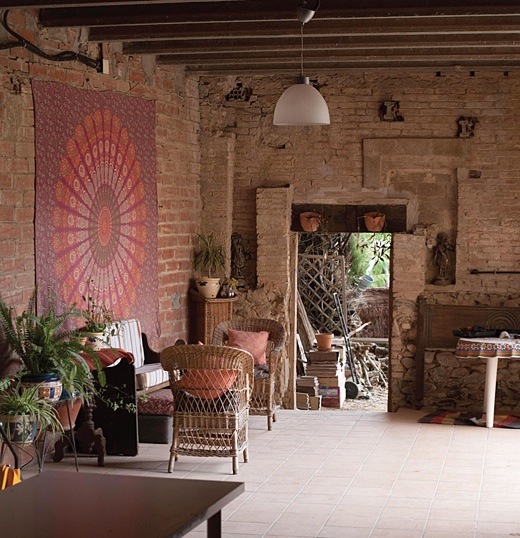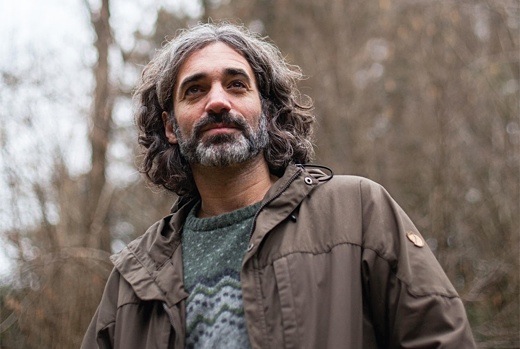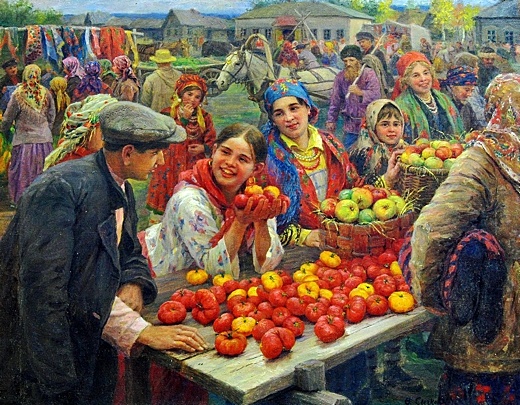SUBHEAD: Patterns of regenerative thinking augur regenerative patterns of living and the reverse is also true.
By Albert Bates on 4 June 2017 for The Great Transition -
(http://peaksurfer.blogspot.com/2017/06/the-way.html)

Image above: A stone Garden Moongate. From (https://www.pinterest.com/pin/90212798755255527/).
Ten years ago, Brian Eno suggested a word to convey the extreme creativity that groups, places or “scenes” can occasionally generate. The word he came up with is “scenius.” Scenius is like genius, only embedded in a scene rather than in genes.
In a Wired interview in 2011, Kevin Kelly described the idea this way:
We have been lucky to stumble into a number of those scenes; so many we sometimes wonder if we are Forrest Gump.
Lucky stars have led us to be present at the birth of the Noho loft art and music scene, Vietnam Veterans Against the War and the Winter Soldier hearings, a blithering Nixon at sunrise on the steps of the Lincoln Memorial, the first Earth Day in Central Park, the Longest Walk, the conspiratorial Leningrad public baths on Saturday nights, the bioregional Consejos de Visiones at Meztitla and Condor, sundry Earth Summits, the ecovillager gatherings at Findhorn in 1995 and Istanbul in 1996, Viridian design, the post-millennium peak oil conferences, and the Kinsale College birthing of Transition.
The scenius we are most familiar with, although it encompasses and interpenetrates many of these others, is of course The Farm.
As one of the longest floating crap games of the past century, it remains a dynamically evolving scene: a creative hub for the world midwives’ conspiracy, the cabal of alternative education advocacy, an incubator for progenitors of cool tech, and lately, a climate-reversal counterdevelopment seeding group, including, but not limited to, we ecovillage, regrarian, permaculture and alt.fuels evangelists.
The geography of scenius is nurtured by several factors that Kelly described:
What Brian Eno called scenius, Stephen Gaskin used to call “the juice.” In a paper we delivered to a history conference in Illinois in 1987, we attempted to describe a series of intellectual and technological steps that guided the first 16 years of The Farm, but cautioned that we could not try to fathom how it came into being.
“How juice moves from place to place and time to time would be an interesting exploration,” we said.
Lao Tsu (literally the “Old Boy” because he was born with a small white beard), put these ideas into poetry. We think it silly when we have to take off shoes and give up our toothpaste at the airport, but when Lao Tsu tried to leave China they told him he couldn’t leave until he had written down all he knew.
In the Tao Te Ching, the 72 gems of wisdom left with a border guard, Lao Tsu summarized his findings in order that he be allowed to leave.
The first verse is the Old Boy’s disclaimer: “The Tao that can be told is not the eternal Tao.”
Alan Watts observed that this famous opening line also showed Lao Tsu to be a punster, but you have to understand a bit of Chinese to get it.
“Tao” means the way, or course, of nature, but it also means to speak. So in Chinese, the first character is this:

The first character is “the way.” The next is “can” or “can be.”
The third is again “the way,” but it could also be “spoken”

What Lao Tsu says in one entendre is that he can’t really describe the way, because it is ineffable; if he could describe it then it would not be true. The way that can be spoken is not the way.
In the other entendre Lao Tsu says it cannot be taken as a way. The way that can be “way-ed,” or traveled, is not the way.
That may be so, but maybe not. Scenius with the grand historicity of a Yosemite Camp 4 cannot be stamped into existence. But the conditions to potentialize scenius can be laid by design. Daniel Wahl, in Designing Regenerative Cultures, provides these basic ingredients:
Orr then takes it a step farther. He says the five billion poor, soon to be 7 or 9 billion, must be empowered with free energy, free clean water, free pressed-brick shelters, and free Internet access. In return they will innovate and create infinite wealth with a regenerative aspect. We hear this, and we shudder a bit.
This is also what Bucky Fuller used to say, and many others before and after him. It’s become kind of holy grail in Silicon Valley or at Burning Man — liberating ideas will liberate masses. It philosophically underpins the UN Sustainable Development Goals — the essence of neoliberalism. But….
Historically, when provided abundant food and energy the hairless two-leggeds have been as locusts.
Without some countervailing ethic of restraint, should Orr’s wish comes true, this fragile blue orb becomes Easter Island.
Wahl says that which must change is more mental than physical, and in this we are agreed. Lately with the climate march for science, Paul Hawken’s Drawdown tour, and the debate over fake news and science suppression we have been hearing, over and over, people we respect make pledges of allegiance to the gods of science as if they were saying a rosary.
But we know that scientists — and even more-so academics — are inherently conservative defenders of the rote and two or more steps behind the vanguard.
Who are the vanguard?
Artists like Brian Eno, or the cabal that gathers in a scenius to thrash out the hard truth. Moreover, they then endeavor to actually make the change they've lived go viral.
Patterns of regenerative thinking augur regenerative patterns of living and the reverse is also true: living together or coming together can change your mind or open new frontiers. We have witnessed this phenomenon in ecovillage communities all over the world.
Designing the future — any future beyond mid-century — requires redesigning a collective consciousness, our psychodemographic. We are already doing this with the hardware gateways to cyberamphibian transits, and with permaculture, ecosystem restoration camps and ecovillages in the non-virtual world.
Ecovillages do it with eco-covenants; social contracts that build all eight forms of capital, externalizing nothing.
Our travels to Marrakech and Zhejiang last year made clear to us that the role of ecovillages is key. They are a viral carrier — patient zero.
Don’t be put off by the hippy or elitist veneers of many of the prototypes; those were leading wedge experiments by the fringe-dwelling creatives. Any change for humanity arrives only after extreme vetting. At that point they become nearly inevitable.
To quote Wahl,
Feeling the wind at our back, we edge the kite closer to the power zone.
By Albert Bates on 4 June 2017 for The Great Transition -
(http://peaksurfer.blogspot.com/2017/06/the-way.html)

Image above: A stone Garden Moongate. From (https://www.pinterest.com/pin/90212798755255527/).
Ten years ago, Brian Eno suggested a word to convey the extreme creativity that groups, places or “scenes” can occasionally generate. The word he came up with is “scenius.” Scenius is like genius, only embedded in a scene rather than in genes.
In a Wired interview in 2011, Kevin Kelly described the idea this way:
"Really, we should think of ideas as connections,in our brains and among people. Ideas aren’t self-contained things; they’re more like ecologies and networks. They travel in clusters."Historical examples are the Yosemite rock climbers Camp 4 in the 1930s, Building 20 at MIT, the Algonquin Round Table, Silicon Valley, Soho, Burning Man, the North Beach of the Big Island in the 1950s, Greenwich Village, the Panhandle flats in the Haight in the 1960s, Glastonbury, Akwesasne, the affinity groups at Seabrook, the bioregional congresses, the World Social Fora, the UN climate summits, and the Amazonian Shamanism conferences.
We have been lucky to stumble into a number of those scenes; so many we sometimes wonder if we are Forrest Gump.
Lucky stars have led us to be present at the birth of the Noho loft art and music scene, Vietnam Veterans Against the War and the Winter Soldier hearings, a blithering Nixon at sunrise on the steps of the Lincoln Memorial, the first Earth Day in Central Park, the Longest Walk, the conspiratorial Leningrad public baths on Saturday nights, the bioregional Consejos de Visiones at Meztitla and Condor, sundry Earth Summits, the ecovillager gatherings at Findhorn in 1995 and Istanbul in 1996, Viridian design, the post-millennium peak oil conferences, and the Kinsale College birthing of Transition.
The scenius we are most familiar with, although it encompasses and interpenetrates many of these others, is of course The Farm.
As one of the longest floating crap games of the past century, it remains a dynamically evolving scene: a creative hub for the world midwives’ conspiracy, the cabal of alternative education advocacy, an incubator for progenitors of cool tech, and lately, a climate-reversal counterdevelopment seeding group, including, but not limited to, we ecovillage, regrarian, permaculture and alt.fuels evangelists.
The geography of scenius is nurtured by several factors that Kelly described:
- Mutual appreciation — risky moves are applauded by the group, subtlety is appreciated, and friendly competition goads the shy. Scenius can be thought of as the best of peer pressure.
- Rapid exchange of tools and techniques — as soon as something is invented, it is flaunted and then shared. Ideas flow quickly because they are flowing inside a common language and sensibility.
- Network effects of success — when a record is broken, a hit happens, or breakthrough erupts, the success is claimed by the entire scene. This empowers the scene to further success.
- Local tolerance for the novelties — the local “outside” does not push back too hard against the transgressions of the scene. The renegades and mavericks are protected by this buffer zone.
What Brian Eno called scenius, Stephen Gaskin used to call “the juice.” In a paper we delivered to a history conference in Illinois in 1987, we attempted to describe a series of intellectual and technological steps that guided the first 16 years of The Farm, but cautioned that we could not try to fathom how it came into being.
“How juice moves from place to place and time to time would be an interesting exploration,” we said.
Lao Tsu (literally the “Old Boy” because he was born with a small white beard), put these ideas into poetry. We think it silly when we have to take off shoes and give up our toothpaste at the airport, but when Lao Tsu tried to leave China they told him he couldn’t leave until he had written down all he knew.
In the Tao Te Ching, the 72 gems of wisdom left with a border guard, Lao Tsu summarized his findings in order that he be allowed to leave.
The first verse is the Old Boy’s disclaimer: “The Tao that can be told is not the eternal Tao.”
Alan Watts observed that this famous opening line also showed Lao Tsu to be a punster, but you have to understand a bit of Chinese to get it.
“Tao” means the way, or course, of nature, but it also means to speak. So in Chinese, the first character is this:

The first character is “the way.” The next is “can” or “can be.”
The third is again “the way,” but it could also be “spoken”

What Lao Tsu says in one entendre is that he can’t really describe the way, because it is ineffable; if he could describe it then it would not be true. The way that can be spoken is not the way.
In the other entendre Lao Tsu says it cannot be taken as a way. The way that can be “way-ed,” or traveled, is not the way.
This is also the point Kelly labored to underscore, which is that scenes, and hence scenius, cannot be created. The best we can hope for is to recognize them when, for whatever extraordinary confluence of good fortune, they seem to arise. And when that happens, the best we can do is to not step on them."Do you think you can make the world a better place? I do not think you can. It is already perfect."
— Lao Tsu
That may be so, but maybe not. Scenius with the grand historicity of a Yosemite Camp 4 cannot be stamped into existence. But the conditions to potentialize scenius can be laid by design. Daniel Wahl, in Designing Regenerative Cultures, provides these basic ingredients:
- Transformative Innovation
- Biologically Inspired
- Living Systems Thinking
- Health and Resilience
Orr then takes it a step farther. He says the five billion poor, soon to be 7 or 9 billion, must be empowered with free energy, free clean water, free pressed-brick shelters, and free Internet access. In return they will innovate and create infinite wealth with a regenerative aspect. We hear this, and we shudder a bit.
This is also what Bucky Fuller used to say, and many others before and after him. It’s become kind of holy grail in Silicon Valley or at Burning Man — liberating ideas will liberate masses. It philosophically underpins the UN Sustainable Development Goals — the essence of neoliberalism. But….
First, the whole modern amusement park ride is scaffolded on cheap, available, abundant energy, soon to be a bygone. Sooner than you imagine, those Microsoft server farms that are allowing you to read this will brown out, flicker, and die. Kevin Kelly again:If I am worthy then show me the way.
A web page relies on perhaps a hundred thousand other inventions, all needed for its birth and continued existence. There is no web page anywhere without the inventions of HTML code, without computer programming, without LEDs or cathode ray tubes, without solid state computer chips, without telephone lines, without long-distance signal repeaters, without electrical generators, without high-speed turbines, without stainless steel, iron smelters, and control of fire. None of these concrete inventions would exist without the elemental inventions of writing, of an alphabet, of hypertext links, of indexes, catalogs, archives, libraries and the scientific method itself. To recapitulate a web page you have to recreate all these other functions. You might as well remake modern society.Second, imagining seven billion hominids empowered with free everything opens the gates of Hell unless they are restrained from reliving the patterns of their collective past, only worse.
Historically, when provided abundant food and energy the hairless two-leggeds have been as locusts.
Without some countervailing ethic of restraint, should Orr’s wish comes true, this fragile blue orb becomes Easter Island.
Wahl says that which must change is more mental than physical, and in this we are agreed. Lately with the climate march for science, Paul Hawken’s Drawdown tour, and the debate over fake news and science suppression we have been hearing, over and over, people we respect make pledges of allegiance to the gods of science as if they were saying a rosary.
But we know that scientists — and even more-so academics — are inherently conservative defenders of the rote and two or more steps behind the vanguard.
Who are the vanguard?
Artists like Brian Eno, or the cabal that gathers in a scenius to thrash out the hard truth. Moreover, they then endeavor to actually make the change they've lived go viral.
Patterns of regenerative thinking augur regenerative patterns of living and the reverse is also true: living together or coming together can change your mind or open new frontiers. We have witnessed this phenomenon in ecovillage communities all over the world.
Designing the future — any future beyond mid-century — requires redesigning a collective consciousness, our psychodemographic. We are already doing this with the hardware gateways to cyberamphibian transits, and with permaculture, ecosystem restoration camps and ecovillages in the non-virtual world.
Ecovillages do it with eco-covenants; social contracts that build all eight forms of capital, externalizing nothing.
Our travels to Marrakech and Zhejiang last year made clear to us that the role of ecovillages is key. They are a viral carrier — patient zero.
Don’t be put off by the hippy or elitist veneers of many of the prototypes; those were leading wedge experiments by the fringe-dwelling creatives. Any change for humanity arrives only after extreme vetting. At that point they become nearly inevitable.
To quote Wahl,
We say “nearly inevitable” because there are still countercurrents and eddies that can drown us. There are no guarantees. The odds against success are high.“Sustainability is not a fixed state to reach and then maintain, it is a community-based learning process aimed at increasing the health and resilience of our communities, our bioregional economies, ecosystems, and of the planetary life-support system as a whole.”
Feeling the wind at our back, we edge the kite closer to the power zone.
This post is the last of a series we dubbed The Power Zone Manifesto. It is a series of building blocks that describe our existential climate dilemma and the only possible way to escape it. We’ll continue to post to The Great Change and Medium on Sunday mornings and 24 to 48 hours earlier for the benefit of donors to our Patreon page. If Power Zone makes it to print, our Power-Up Patreon donors will receive an autographed copy.."If you want to be reborn, let yourself die. If you want to be given everything, give everything up."
— Lao Tsu
